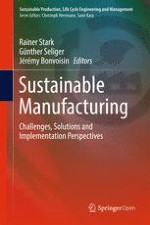Open Access 2017 | Open Access | Buch

Sustainable Manufacturing
Challenges, Solutions and Implementation Perspectives
herausgegeben von: Rainer Stark, Günther Seliger, Jérémy Bonvoisin
Verlag: Springer International Publishing
Buchreihe : Sustainable Production, Life Cycle Engineering and Management